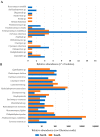Culture-Dependent and Amplicon Sequencing Approaches Reveal Diversity and Distribution of Black Fungi in Antarctic Cryptoendolithic Communities
- PMID: 33809619
- PMCID: PMC8001563
- DOI: 10.3390/jof7030213
Culture-Dependent and Amplicon Sequencing Approaches Reveal Diversity and Distribution of Black Fungi in Antarctic Cryptoendolithic Communities
Abstract
In the harshest environmental conditions of the Antarctic desert, normally incompatible with active life, microbes are adapted to exploit the cryptoendolithic habitat (i.e., pore spaces of rocks) and represent the predominant life-forms. In the rocky niche, microbes take advantage of the thermal buffering, physical stability, protection against UV radiation, excessive solar radiation, and water retention-of paramount importance in one of the driest environments on Earth. In this work, high-throughput sequencing and culture-dependent approaches have been combined, for the first time, to untangle the diversity and distribution of black fungi in the Antarctic cryptoendolithic microbial communities, hosting some of the most extreme-tolerant microorganisms. Rock samples were collected in a vast area, along an altitudinal gradient and opposite sun exposure-known to influence microbial diversity-with the aim to compare and integrate results gained with the two approaches. Among black fungi, Friedmanniomyces endolithicus was confirmed as the most abundant taxon. Despite the much stronger power of the high-throughput sequencing, several species were not retrieved with DNA sequencing and were detectable by cultivation only. We conclude that both culture-dependent and -independent analyses are needed for a complete overview of black fungi diversity. The reason why some species remain undetectable with molecular methods are speculated upon. The effect of environmental parameters such as sun exposure on relative abundance was clearer if based on the wider biodiversity detected with the molecular approach.
Keywords: Antarctica; black fungi; cryptoendolithic communities; extremophiles; metabarcoding.
Conflict of interest statement
The authors declare no conflict of interest.
Figures






Similar articles
-
Endolithic Fungal Species Markers for Harshest Conditions in the McMurdo Dry Valleys, Antarctica.Life (Basel). 2020 Feb 6;10(2):13. doi: 10.3390/life10020013. Life (Basel). 2020. PMID: 32041249 Free PMC article.
-
Sun Exposure Shapes Functional Grouping of Fungi in Cryptoendolithic Antarctic Communities.Life (Basel). 2018 Jun 2;8(2):19. doi: 10.3390/life8020019. Life (Basel). 2018. PMID: 29865244 Free PMC article.
-
Beyond the extremes: Rocks as ultimate refuge for fungi in drylands.Mycologia. 2021 Jan-Feb;113(1):108-133. doi: 10.1080/00275514.2020.1816761. Epub 2020 Nov 24. Mycologia. 2021. PMID: 33232202
-
Lithobiontic life: "Atacama rocks are well and alive".Antonie Van Leeuwenhoek. 2018 Aug;111(8):1333-1343. doi: 10.1007/s10482-018-1033-9. Epub 2018 Feb 1. Antonie Van Leeuwenhoek. 2018. PMID: 29392527 Review.
-
Microorganisms in desert rocks: the edge of life on Earth.Int Microbiol. 2012 Dec;15(4):173-83. doi: 10.2436/20.1501.01.170. Int Microbiol. 2012. PMID: 23844476 Review.
Cited by
-
Applying EDTA in Chelating Excess Metal Ions to Improve Downstream DNA Recovery from Mine Tailings for Long-Read Amplicon Sequencing of Acidophilic Fungi Communities.J Fungi (Basel). 2022 Apr 20;8(5):419. doi: 10.3390/jof8050419. J Fungi (Basel). 2022. PMID: 35628675 Free PMC article.
-
Cold Adaptation Strategies and the Potential of Psychrophilic Enzymes from the Antarctic Yeast, Glaciozyma antarctica PI12.J Fungi (Basel). 2021 Jun 30;7(7):528. doi: 10.3390/jof7070528. J Fungi (Basel). 2021. PMID: 34209103 Free PMC article. Review.
-
Circumfusicillium cavernae gen. et sp. nov. (Bionectriaceae, Hypocreales) Isolated from a Hypogean Roman Cryptoporticus.J Fungi (Basel). 2022 Aug 10;8(8):837. doi: 10.3390/jof8080837. J Fungi (Basel). 2022. PMID: 36012824 Free PMC article.
-
The poly-extreme tolerant black yeasts are prevalent under high ultraviolet light and climatic seasonality across soils of global biomes.Environ Microbiol. 2022 Apr;24(4):1988-1999. doi: 10.1111/1462-2920.15969. Epub 2022 Mar 24. Environ Microbiol. 2022. PMID: 35324062 Free PMC article.
-
1,8-Dihydroxynaphthalene (DHN) melanin provides unequal protection to black fungi Knufia petricola and Cryomyces antarcticus from UV-B radiation.Environ Microbiol Rep. 2024 Dec;16(6):e70043. doi: 10.1111/1758-2229.70043. Environ Microbiol Rep. 2024. PMID: 39548356 Free PMC article.
References
-
- Zucconi L., Onofri S., Cecchini C., Isola D., Ripa C., Fenice M., Madonna S., Reboleiro-Rivas P., Selbmann L. Mapping the lithic colonization at the boundaries of life in Northern Victoria Land, Antarctica. Polar Biol. 2016;39:91–102. doi: 10.1007/s00300-014-1624-5. - DOI
LinkOut - more resources
Full Text Sources
Other Literature Sources

